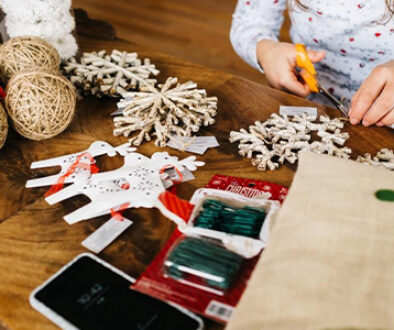School At Home: Routines And Rhythms That Actually Work

If you have been feeling a weird sort of pressure to try to replicate the school day and schedule that your children are used to in this season, you can breathe a little easier with what I am about to share.
As an experienced classroom teacher who is now a homeschooling-while-running-a-home-based-business mom, I had to learn how to let go of everything I knew about what my “classroom” was supposed to be like.
And if you want to be successful at implementing and maintaining an effective classroom at home — that’s what I want you to do. Lovingly release those expectations into the air much the way you would a butterfly. Kiss them goodbye.
You basically need to rewire your brain because the traditional classroom and the classroom in your house are two totally different things.
These are the four traditional school rules that I’m not just giving you permission to break. You can ball these bad boys up and toss them right out the window.
Rule #1 – The academic work of school takes 7-8 per day.
If you’re going to break the school rules, this is one of the best places to start! Academics does not need to be done on any specific timetable. At home, it should be completed according to each child’s individual needs.
Some children can get their work done in just a couple of hours. Great. Younger children should spend less time than older children doing focused academic work. In your home, more work can be accomplished in less time because class shifts, rotations, announcements, group work, and other activities that are typical for a learning environment that consists of many children aren’t a necessary part of the home school day.
If your students already understand a particular concept or are showing mastery of a specific skill, they don’t need to spend extra time working on additional problems or practice work. And they don’t have to wait while their teacher assists other students in the class.
What’s the main takeaway here? The individual learning needs of your children run your home school. Once you nail down a schedule that works for your family, you get to use all that extra time during the day for things like faith, freedom and fun! This means more opportunities for activities like exercise, outreach, extracurriculars, and finding ways for your children to develop their unique abilities and talents.
Doesn’t that sound amazing?
Rule #2 – Kids learn best by sitting at desks, facing forward, while a teacher presents material at the front of the room.
Thank you, but no. I say that as I pull back the covers on my daughter’s bed and we snuggle up together to review Setting, Characters, and Conflict while reading Because of Winn-Dixie (for the 8th time in as many weeks).
You’ve let go of the lie that your child’s schoolwork takes the same amount of time as your work shift. Now, it’s time to let go of this one.
In public school, we teachers have to maintain order in classrooms with large numbers of students. At home, that’s not the case.
I’m giving you full permission to do school in your house wherever it works best for you and your learners. Kitchen table. Out on the patio. In the backyard on the trampoline. Sprawled out on the floor. Now it might be good for your child to work at a table, sitting in a chair, but ask yourself:
Can the work be accomplished just as well if my child is on the living room rug, on the couch, or snuggled up in their bed?
Many children are active and might work better while standing on their feet or moving around. If their minds are prone to wander a little (or a lot), sometimes working in a different location or to the beat of some music can help them focus and handle their business a bit better.
My absolute favorite way of conducting any literature lesson is lying in my daughter’s bed, snuggled up under her blankets. Breaking the rule of “you must sit at a desk or table” can be one of the best ways to help your children see that they can learn wherever they are.
Rule #3 – Every student needs an official curriculum for every subject
Nope. Absolutely not. In fact, I don’t think you could find two families who use exactly the same curriculum in exactly the same way. Set this rule on fire and walk away from the flames and into curricular freedom!
Use what you want for whatever subject you want.
What’s cool is that you get to tailor your child’s learning experience to his or her specific needs and interests. Maybe you love one curriculum or a set of lessons for math, but a completely different one for science. Not a problem. Maybe one curriculum will work well for most of your student’s schoolwork, but you want to add in some other lessons. That’s fine, too.
Rule #4 – To be a teacher, you have to be an expert.
This is not accurate, yet it is one of the major stumbling blocks for parents who want to teach their children.
A child’s learning depends on a variety of factors:
- ability to pay attention and focus
- maturity level
- learning style
- intellectual capability
- interest in a particular subject
- materials available
- and about a hundred other things that I don’t have time to mention
Even if you are not an expert in certain (or any) academic areas, there are several ways you can help your children learn even the most challenging concepts. Plus you can use this as an opportunity to learn something new right alongside your child. You can grow in knowledge and skill together!
P.S. SUPER SPECIAL ANNOUNCEMENT…
I am hosting a brand new mentorship series, The Heroic Homeschooler starting August 20!
To make sure you don’t miss out on any of the details be sure to register by clicking the link below>>
https://truthbecomesher.com/homeschool-1/
Need a copy of my newest book? You can grab one HERE!




